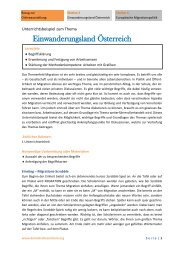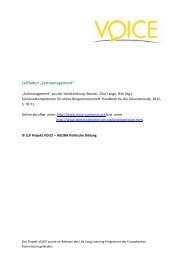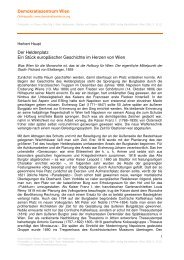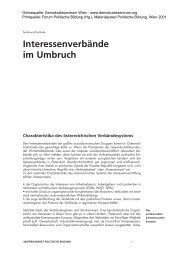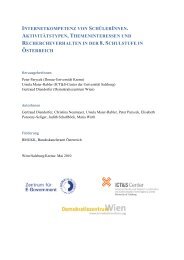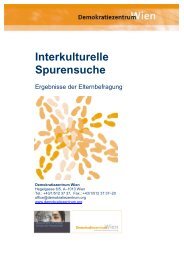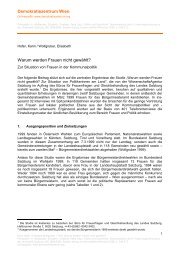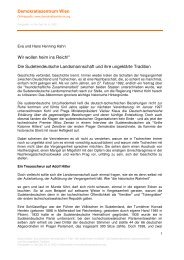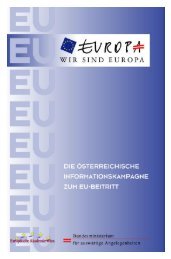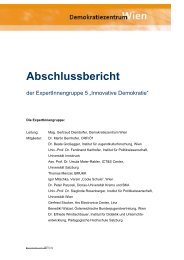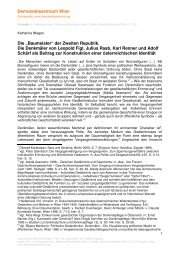Historical Truth Impossible? - Demokratiezentrum Wien
Historical Truth Impossible? - Demokratiezentrum Wien
Historical Truth Impossible? - Demokratiezentrum Wien
You also want an ePaper? Increase the reach of your titles
YUMPU automatically turns print PDFs into web optimized ePapers that Google loves.
<strong>Demokratiezentrum</strong> <strong>Wien</strong><br />
Onlinequelle: www.demokratiezentrum.org<br />
Quelle: paper presented at the GSA (German Studies Association) Meeting 2003 (September 18-21) in New Orleans..<br />
Oliver Rathkolb<br />
<strong>Historical</strong> <strong>Truth</strong> <strong>Impossible</strong>? Nazi-Looted Schiele Paintings and the<br />
New York and Los Angeles Court Cases<br />
When Jonathan Petropoulos and I presented papers on looted art restitution issues in<br />
Switzerland and Austria on a panel concerning “Kunstraub and Memory” at the 1997 (Sept. 26 th )<br />
GSA meeting our commentator, Professor Henry Friedländer, was nice to us “young boys”, but<br />
clearly indicated that what we were dealing with was not real business, not real holocaust<br />
history. Property issues should be left to the lawyers, and we should care more about victim’s<br />
and genocide history. Friedländer’s views represented a mainstream perception at that time,<br />
which, by the way, has negatively affected the otherwise perfect archival microfilming policy of<br />
documents all over the world by the Holocaust Memorial Museum in Washington, DC, where,<br />
until recently, property issues have been completely marginalized.<br />
However, just a few month later, on Christmas Eve 1997, the international media and the<br />
Clinton administration began to respond to a new debate in a new era led by a younger<br />
generation that focussed on property issues as a symbol for renegotiating World War II and<br />
Holocaust history. In a time of globalisation and growing importance and interest in individual<br />
human rights (overruling the traditional reparation issues of states and state agreements that<br />
create a permanent closure of these issues), World II and post-war looted art issues became<br />
media icons.<br />
With respect to historiography, applied history around the holocaust era assets debate became<br />
quite trendy despite the broad methodological shift around postmodernism and the widely<br />
acknowledged assumption that historians cannot produce absolute truth, and history, thus, is<br />
not fundamentally different from myth or fiction. Suddenly, even advocates of cultural studies<br />
accepted the idea that historians still can contribute to debates on values in the holocaust era<br />
assets discussions, not by each side simply asserting its own values, but by empirical evidence<br />
and thorough analysis and interpretation of this evidence.<br />
In Austria, general public opinion shifted focus to specific individual Nazi era art claims by two<br />
families concerning two paintings from the Austrian expressionist Schiele. The paintings were<br />
on display at the Museum of Modern Art in New York, on loan from the private (state<br />
subsidized) Leopold Foundation. 1 On January 7, 1998, the Manhattan District Attorney<br />
confiscated the two paintings (“Portrait of Wally” and “Dead City”) starting a criminal<br />
investigation into the ownership of the paintings and providing evidence for a possible trial<br />
before a grand jury. 2<br />
It should be noted that this incident was not merely on the sidelines of the “Swiss Nazi Gold<br />
Bank“ discussion, but became part of a much broader debate in the US dealing with the<br />
sometimes dubious ownership of alleged Nazi loot on display in several museums in the US and<br />
Canada – paintings claimed by heirs of Holocaust victims. 3 A painting, which I presented in<br />
1997 as missing art (stolen by the Reichs- und Gauleiter Baldur von Schirach in 1942) turned up<br />
in North Carolina.<br />
1 New York Times, December 24, 1997.<br />
2 New York Times, January 8, 1998.<br />
3 Boston Globe, July 24, 1997.<br />
Oliver Rathkolb • Titel: <strong>Historical</strong> <strong>Truth</strong> <strong>Impossible</strong>?<br />
Quelle: paper presented at the GSA (German Studies Association) Meeting 2003 (September 18-21) in New Orleans. • Quelle<br />
online: www.demokratiezentrum.org<br />
1
<strong>Demokratiezentrum</strong> <strong>Wien</strong><br />
Onlinequelle: www.demokratiezentrum.org<br />
Quelle: paper presented at the GSA (German Studies Association) Meeting 2003 (September 18-21) in New Orleans..<br />
The painting in question is “Madonna and child in a landscape", circa 1518, by Lucas Cranach<br />
the Elder, and it now hangs in a place of prominence in the North Carolina Museum of Art in<br />
Raleigh, which values it at some $750,000. The Cranach had been the property of the Viennese<br />
Austrian collector Philipp Gomperz, who fled Austria. After the war, Schirach was imprisoned for<br />
war crimes (asserting that the “Russians“ had stolen the painting when they liberated Vienna in<br />
1945), but the Cranach was sold to the New York dealer Siegfried Thalheimer, who sold it to<br />
Abraham Silberman, another dealer, who sold it to a collector in Beverly Hills, George Khuner.<br />
Mr Khuner, like Mr Silberman an Austrian Jew, had the picture authenticated by William R.<br />
Valentiner, who founded the North Carolina Museum of Art in 1955. The whole issue was<br />
settled in perfect mediation, the museum paying compensation to the two sisters who were the<br />
heirs of the Gomperz collection after the painting was unearthed by the World Jewish Congress<br />
“Commission for Art Recovery.“ This commission, chaired by former US Ambassador to Austria,<br />
Ronald Lauder, who also happens to be the chairman of the MOMA, was established before the<br />
MOMA-Schiele incident.<br />
The impact of the MOMA incident on the international debate about looted art was stunning,<br />
compared with the Austrian tradition of suppressing its Nazi past and reducing any restitution or<br />
compensation to a minimum. No one would have believed in 1997 that restitution issues would<br />
be renegotiated. Even the Grand Coalition of Social Democrats and Conservative People’s<br />
Party, successor parties of the two dominant post-war forces who only unwillingly, and primarily<br />
under Allied pressure, carried out individual restitution after the end of World War II passed new<br />
legislation on the restitution of looted art. On November 5, 1998, the National Council of the<br />
Austrian Parliament unanimously passed a law to restitute looted art from the Nazi period<br />
(including the immoral trade off since the export prohibition law has been amended not to<br />
include these objects previously). Since this law is limited to State owned collections, provincial<br />
and municipal authorities have established research commissions to screen their collections for<br />
Nazi looted art (e.g. the <strong>Historical</strong> Museum of Vienna or the museums of the City and of the<br />
Province of Upper Austria in Linz, etc 4 .). Smoking guns are still buried in Austria’s Nazi past, but<br />
obviously a new generation of journalists, academics and politicians are prepared to face this<br />
past and unearth the truth - even if this hurts not only the national memory, but also means<br />
concrete efforts for restitution of material losses. Even one of the dominant figures in Austrian<br />
national heritage and identity, Johann Strauß, – the King of Vienna Waltz – was affected. His<br />
and his family’s papers were restituted and then bought back by the City of Vienna 5 . Here, too,<br />
bureaucracy was pursuing a closed-door policy, but when a political and media debate started,<br />
all information was ultimately made available to the public on the Internet. This continued slow<br />
handling is a indicator that it takes time to accept the new perceptions in the looted art issue.<br />
4<br />
More details on provincial collections see: Vienna<br />
(http://www.museum.vienna.at./dynamicPage.asp?MenuID=1906), Residenzgalerie Salzburg<br />
(http://www.residenzgalerie.at), Rupertinum, Museum für moderne Kunst, Salzburg (http://www.rupertinum.at),<br />
Salzburger Museum Carolino Augusteum (http://www.scma.at), Inventarbuch der Landesgalerie Salzburg 1942-44.<br />
Mit Farbabbildungen der 19 aus Frankreich stammenden Kunstwerke<br />
(http://www.salzburg.gv.at/inventarbuch/index.htm), Restitution am Landesmuseum Joanneum, Graz<br />
http://www.museum-joanneum.at/restitution,<br />
(http://www.linz.at/archiv/gurlitt/bericht.htm)<br />
Sammlung Gurlitt der Neuen Galerie der Stadt Linz<br />
5<br />
More details on the so called Sammlung Strauß-Meyszner and Sammlung Strauß-Simon, in: Maria Wirth,<br />
Restitution von Bibliotheksbeständen nach 1945: Die Verhandlungen über die Strauß-Sammlungen in der <strong>Wien</strong>er<br />
Stadt- und Landesbibliothek, paper presented at “Raub und Restitution in Bibliotheken“. Internationale Tagung im<br />
<strong>Wien</strong>er Rathaus, 23.-24. April 2003, published in:<br />
http://www.stadtbibliothek.wien.at/bibliothek/veranstaltungen/restitution/abstracts/wirth.pdf<br />
Oliver Rathkolb • Titel: <strong>Historical</strong> <strong>Truth</strong> <strong>Impossible</strong>?<br />
Quelle: paper presented at the GSA (German Studies Association) Meeting 2003 (September 18-21) in New Orleans. • Quelle<br />
online: www.demokratiezentrum.org<br />
2
<strong>Demokratiezentrum</strong> <strong>Wien</strong><br />
Onlinequelle: www.demokratiezentrum.org<br />
Quelle: paper presented at the GSA (German Studies Association) Meeting 2003 (September 18-21) in New Orleans..<br />
Why is the looted art debate so strong?<br />
The symbolism of art objects has always been extremely striking – especially art that has been<br />
looted during military aggression and has been transferred to the museums of the occupier and<br />
turned into rather archaic symbols of victory and continuing strength over the defeated<br />
opponent. (Even in the former Soviet Union, the sheer knowledge about “trophy art“ was<br />
politically strong enough so that the actual objects mostly were stored and not shown to the<br />
public). They are always visible in the minds of both the victors and the victims (and still are<br />
today if one follows the discussion about the return of looted art from Russia).<br />
I would even argue that there is no difference between state organized collective memory about<br />
looted art and the individual private memory of art owners and their heirs – the video artist Vera<br />
Frenkel tried to express these feeling in three projects – transit bar, body missing and body<br />
missing web site 6 . Focussing on the planned Führermuseum in Linz and the already looted art<br />
objects (most of them from collections of Jews from all over Europe), Frenkel interprets state<br />
driven looted art as another form of cannibalism – to gain in strength through stealing the other<br />
(the enemy’s) power symbols. She makes quite clear that this process does not end; according<br />
to Siegfried Kracauer’s conception of history: History neither ends nor is she open to aesthetic<br />
redeem.<br />
In the Austrian museum scene, directors and curators still had problems reversing the process,<br />
but the political elites in the government and US and media pressure overruled their perceptions<br />
– except in the case of the 5 (later 6) Klimt paintings from the Bloch-Bauer collection in the<br />
Österreichische Galerie in the Belvedere. After 1945 the identity of the Austrian elite in the<br />
depressing social, economic and political environment after 1945 very much needed high<br />
culture and art as symbols of power – leftovers of former power. Therefore, these constructive<br />
components of the Austrian small state identity, based on the fiction of representing the former<br />
glorious past of the Habsburg monarchy, seemed for decision makers and especially<br />
bureaucrats too important to be returned. In a secret plan, some art objects where even sent as<br />
a wandering exhibition overseas in the hot days of the Cold War in the 1940s and 1950s to be<br />
used in case of all out warfare as property for an Austrian government in exile. An all out<br />
restitution policy, too, was seen at that time as an acceptance of political responsibility for the<br />
destruction of the Jewish Community of Austria, World War II and the Holocaust.<br />
In the 1990s, however, the privatisation of the former state controlled banking and industry<br />
section started, and thus the return of state property seemed to be easier. One could even<br />
speak of the first steps towards privatisation as national symbols of identity. In the field of forced<br />
labour compensation, the Austrian Social Democratic Chancellor Viktor Klima even went so far<br />
as to declare that these issues were to be solved by industry and banks themselves since they<br />
were private businesses.<br />
With regard to the MOMA-Schiele case and the 2 paintings from the Leopold collection, both<br />
where released in 1998 by a NY court. One, however confiscated by the US government and<br />
one returned to Austria. I shall not go into further details concerning this case, which has been<br />
relatively well documented but is still in legal dispute 7 dominated by the key issue of who is the<br />
real heir. Several months after this seizure, evidence has been uncovered that seems to<br />
6<br />
Vera Frenkel, Die Macht der Abwesenheit: Schweigen, Schatten und Erinnerung, in: Sigrid Schade, Gottfried Fliedl,<br />
Martin Sturm (Hrsg.), Kunst als Beute: zur symbolischen Zirkulation von Kulturobjekten, <strong>Wien</strong> 2000, 143-170.<br />
7<br />
Compare for the legal background of this case Laurie Brook Zimmerman, The People of the State of New York<br />
Versus The Museum of Modern Art. A Case Study with Recommendations. Paper for a Masters Degree Candidate in<br />
Commercial Diplomacy to be presented on April 19, 2000, published in<br />
http://www.commercialdiplomacy.org/ma_projects/zimmerman.htm<br />
Oliver Rathkolb • Titel: <strong>Historical</strong> <strong>Truth</strong> <strong>Impossible</strong>?<br />
Quelle: paper presented at the GSA (German Studies Association) Meeting 2003 (September 18-21) in New Orleans. • Quelle<br />
online: www.demokratiezentrum.org<br />
3
<strong>Demokratiezentrum</strong> <strong>Wien</strong><br />
Onlinequelle: www.demokratiezentrum.org<br />
Quelle: paper presented at the GSA (German Studies Association) Meeting 2003 (September 18-21) in New Orleans..<br />
indicate that neither the Reifs nor the Bondis had legitimate claims. In the instance of "Dead City<br />
III," the painting was claimed by the widow of a son of the pre-war owner's cousin. However the<br />
cousin was not an heir to the painting. In the case of "Portrait of Wally," the situation is even<br />
more convoluted. Henry Bondi, the claimant for his deceased aunt, Lea Bondi Jaray, wrote<br />
about his vivid recollections of having seen the painting in his aunt's house in Vienna before the<br />
war. But, according to the pre-war owner's grandson, the claimant never saw the painting, never<br />
set foot in the house in Vienna, and the claimant recently conceded in a British newspaper<br />
interview that he is not even an heir.<br />
The second case I shall use to develop my theme about “historical truth” and the renegotiation<br />
of collective memory is the so-called Altmann-case 8 . Ms. Maria Altmann is one of the heirs of<br />
the Ferdinand Bloch-Bauer family. She filed a case in a federal district court in Los Angeles in<br />
August 2000 after the Austrian Kommission für Provenienzforschung recommended not<br />
restituting five Klimt paintings – the famous portraits “Adele Bloch-Bauer I und II”, “Apfelbaum I",<br />
"Buchenwald (Birkenwald)" und "Häuser in Unterach am Attersee", which allegedly were<br />
acquired by the Österreichische Galerie based on the last will of Adele Bloch-Bauer, written in<br />
1923. A legal case in an Austrian court would have cost $400,000 in a deposit for the court<br />
costs. An international arbitration, as proposed by Schönberg, was not accepted by the Austrian<br />
state representatives. The Austrian legal situation is quite unclear. The two legal experts hired<br />
by Ms. Altmann’s lawyer, E. Randol Schönberg (a grandson of Arnold Schönberg, the famous<br />
composer), Dr. Lintl, and the University Professor Welser, tend to back her views. The State<br />
authorities argue that, according to previous court decisions, they would win a court case. A<br />
professional historical analysis is still missing.<br />
But with media representations shaping perceptions, neither a legal nor a historical analysis will<br />
work. After five years this case has already been decided with regard to the international<br />
perception due to the closed-door public relation policy of the Austrian government. Whatever<br />
the court decides, Ms. Altmann will win – even if she and/or other heirs never obtain the<br />
paintings.<br />
Can collective memories be renegotiated by art restitution?<br />
I fully agree with Elazar Barkan 9 and his interpretation of “amending injustices in negotiations in<br />
which both victims and perpetrators can share “history and memory”. I, however, would like to<br />
test his model for a shared, negotiated history, which should be different from the static and<br />
one-way narrative of previous historiography as well as of collective memory.<br />
Focussing on the looted art cases chosen for this paper, the first very important topic is related<br />
to the generational approach. In these cases, first, second and third generations negotiate<br />
about history through restitution, mixing family transformed historical artefacts with fragmentary<br />
historical constructions, which in most cases concentrate – like in a legal statement – only on<br />
one side of the “story” and very rarely integrate both the spoliation and the restitution issues. (In<br />
these cases, looting by the Nazis and fellow citizens in Germany, Austria, France, and<br />
Netherlands etc.).<br />
8 A large documentary internet site by the Lawyer of Ms. Maria Altmann, Randolph Schönberg is www.adele.at. The<br />
commentaries are exclusively written from the point of view of Ms. Altmann and her lawyer, the documents include,<br />
however, the “other” side, too, but most of them are in German and will not be read from the majority of the<br />
international public.<br />
9 Elazar Barkan, Guilt of Nations: Restitution and Negotiating <strong>Historical</strong> Injustices, New York: W. W. Norton. 2000.<br />
Oliver Rathkolb • Titel: <strong>Historical</strong> <strong>Truth</strong> <strong>Impossible</strong>?<br />
Quelle: paper presented at the GSA (German Studies Association) Meeting 2003 (September 18-21) in New Orleans. • Quelle<br />
online: www.demokratiezentrum.org<br />
4
<strong>Demokratiezentrum</strong> <strong>Wien</strong><br />
Onlinequelle: www.demokratiezentrum.org<br />
Quelle: paper presented at the GSA (German Studies Association) Meeting 2003 (September 18-21) in New Orleans..<br />
In the looted art cases, you very rarely find “first” generations involved anymore. Primarily,<br />
second and third generations are part of the debate. Still the strongest cases with media<br />
attention and political power are those involving first generations, such as in the Klimt-Case of<br />
Ms. Maria Altmann, the niece of Ferdinand Bloch-Bauer, since they still are holocaust survivors<br />
and, during the last decades, have obtained considerable moral power in Western Europe and<br />
the US.<br />
The second generation and the third generation have in many cases overcome the original<br />
traumatisation of the first generation, which pursued their restitution claims in an unfriendly<br />
environment with the Cold War soon overruling even US official assistance for refugees and<br />
new US citizens if naturalized during or after World War II.<br />
On the side of the second and third generations of the perpetrator and bystander groups in<br />
Germany, Austria, France, the Netherlands etc., the various national commissions have<br />
unearthed a considerable amount of non-Nazi collaboration of European societies, especially in<br />
the looting of mostly “Jewish property.” A broader awareness of the horrors of the Holocaust<br />
and the amount of collaboration, or even active participation, of their ancestors has taken place.<br />
However, the general tendency to “draw a line” still dominates the various societies, a tendency,<br />
however, not always accepted by elites and elite media.<br />
However, compared with the role of perpetrators and bystanders during the immediate post-<br />
World War II restitution trials, these attitudes have changed. You will now find in all restitution<br />
trials a strong tendency to overrule the victims’ narratives by balancing these memories by<br />
personal memories of victimization during or after the war as a consequence of Allied bombing,<br />
looting, loss of family members on the battlefield, and during the de-Nazification period, which<br />
could include internment, confiscation, temporary job loss, etc.<br />
The debates in the 1990s about “Swiss Nazi Gold” and Nazi Forced Labour have broadened<br />
public interest and awareness but are still not a strong component of national collective<br />
memories, maybe because of the narrow national approaches. A broadening of the debate and<br />
an end of national approaches would certainly strengthen this awareness.<br />
A classical example for a neo-national, third generation victims only approach is the best selling<br />
book by Tina Walzer and Stephan Templ, "Unser <strong>Wien</strong>: ‘Arisierung’ auf Österreichisch”, Berlin:<br />
Aufbau Verlag, 2001 which dealt with the wholesale seizure of Jewish property in Vienna by<br />
specifically linking the names of the original Jewish owners to the individual expropriators of<br />
their apartments, villas, art works, businesses, personal fortunes. The restitution issues,<br />
however, were completely neglected. It is a victim-oriented view, which is perceived as morally<br />
perfected. If you go into the details of the book, however, even this one-way narrative is not well<br />
researched, streamlining facts that do not correspond with the aryanization only views (e.g. a<br />
photograph from the Institute of Contemporary History of Vienna that shows Adolf Hitler at the<br />
train station in St. Pölten and a small advertisement of the Vienna auction house “Dorotheum” in<br />
the background is transformed into “Adolf Hitler visiting the Dorotheum”, a Vienna Banking<br />
house. According to the authors, Reitzes, from a well known family and a key target of Karl<br />
Lueger’s Anti-Semitism, is looted, but due to the fact that the last Jewish owner died before<br />
1938 and his “Aryan” widow and there collaborators continued business until 1944, etc. etc.)<br />
*To make it quite clear, this critique does not change my views and interpretations of the all-out,<br />
brutal and aggressive aryanization policies and Austrian collaboration in 1938 and the shameful<br />
half-hearted and perpetrator-friendly restitution and compensation policies. But I think that<br />
historiography should not focus solely on one-way narratives and analyse long-range<br />
Oliver Rathkolb • Titel: <strong>Historical</strong> <strong>Truth</strong> <strong>Impossible</strong>?<br />
Quelle: paper presented at the GSA (German Studies Association) Meeting 2003 (September 18-21) in New Orleans. • Quelle<br />
online: www.demokratiezentrum.org<br />
5
<strong>Demokratiezentrum</strong> <strong>Wien</strong><br />
Onlinequelle: www.demokratiezentrum.org<br />
Quelle: paper presented at the GSA (German Studies Association) Meeting 2003 (September 18-21) in New Orleans..<br />
developments, but rather, it should deal with all narratives, both on the national and individual<br />
levels.<br />
However, a highly problematic issue is that the classical legal court procedure destroys the<br />
option for a broader public “mediation.” This is the primary weakness of Austrian legislation in<br />
looted art issues in that it still is state structured. In the specific cases of looted art, a major<br />
obstacle derives from different legal traditions and legal tiles of obtaining property in good faith,<br />
with US legal traditions requiring a strict chain of legal ownership and a European tradition<br />
accepting obtaining property by good faith.<br />
From the beginning, a key failure of the Austrian legislation, which was praised by the then US<br />
Undersecretary of State Stuart Eizenstat, was the lack of public transparency and mediation<br />
efforts. Even today, if you visit the Bundesdenkmalamt website (www.bda.at), there is no direct<br />
reference to the Commission for the Investigation of Provenance of Art Objects of the Federal<br />
Ministry for Education and Culture of Austria, led by Ernst Bacher, Generalkonservator<br />
Bundesdenkmalamt. At least in the Archive reference you find a list of the materials open for<br />
research on looted art.<br />
In the Altmann-case, this closed procedure consisted of a group of experts including two<br />
historians, Helmut Konrad from Graz and the director of the Military Museum in Vienna,<br />
Manfried Rauchensteiner, both who have never worked or published in the field of looted art,<br />
was dominated by legal experts. The group composed an “Empfehlung”, a non-binding<br />
recommendation for the Minister of Education, and have still yet to return the disputed art<br />
objects or objects of unclear provenience to the rightful owners and their heirs. E. Randol<br />
Schönberg, the lawyer for Ms. Altmann, argues, “The Bloch-Bauer heirs and their attorney had<br />
been purposely excluded from the entire decision-making process”.<br />
The positive part of the decision of the Commission (one member did not vote and left the<br />
Commission), to return 16 other Klimt drawings and 19 porcelain settings that had been donated<br />
by the family in 1948 as part of “deal under pressure” to obtain export permits, was not covered<br />
in the public debate because the decision not to return the remaining 5 paintings now in the<br />
Austrian Gallery at the Belvedere, valued at US$ 150 Million, overruled the positive message.<br />
This closed-door policy destroyed the aim and spirit of the law and harmed the reputation of the<br />
commission, which is not a court under specific rules but just an expert commission for the<br />
Minister and does not hold public hearings. Still, state officials play an important role in the<br />
commission, which neither by composition nor by the legal framework could develop into an<br />
arbitration committee.<br />
In general, the procedure – although extremely slow, too slow in my opinion – of late restitution<br />
functions well, having so far restituted art objects worth 5 billion Austrian schillings or, according<br />
to US sources, 400 Million US Dollars. After the media and political debate with regard to the<br />
restitution of the Rothschild property and the later auction by Christie’s (ending with the largest<br />
sale earnings in one auction in Europe, $90,7 million), as well as the Strauß case, the Austrian<br />
public has rarely been informed about the cases. Neither the press nor the Kommission für<br />
Provenienzforschung reports regularly on these issues, the only exemption being the Altmancase,<br />
which has defined and shaped the international and national perception of complete art<br />
restitution efforts in Austria since the late 1990s – at least according to the values returned, in a<br />
1999 estimate 2 Billion Austrian Schillings, or 150 Million US Dollars).<br />
To come back to the striking and dominating Altmann case, a recently discovered new series of<br />
documents from 1919 and the 1920s seems to prove that Adele Bloch-Bauer seemed to<br />
Oliver Rathkolb • Titel: <strong>Historical</strong> <strong>Truth</strong> <strong>Impossible</strong>?<br />
Quelle: paper presented at the GSA (German Studies Association) Meeting 2003 (September 18-21) in New Orleans. • Quelle<br />
online: www.demokratiezentrum.org<br />
6
<strong>Demokratiezentrum</strong> <strong>Wien</strong><br />
Onlinequelle: www.demokratiezentrum.org<br />
Quelle: paper presented at the GSA (German Studies Association) Meeting 2003 (September 18-21) in New Orleans..<br />
earmark the five paintings for the Österreichische Galerie 10 even before 1923. Already in<br />
October 1945, Ferdinand Bloch-Bauer allegedly knew that two paintings of Klimt, “Damenbildnis<br />
vor Goldgrund” und “Apfelbaum” “have been transferred to the Austrian Gallery according to the<br />
last will of his wife”, and he did not intervene.<br />
With the exception of historical research and analysis, the debates have completely shifted to<br />
legal argumentation. The representatives of the Republic of Austria are advocating the validity<br />
of the last of will of Adele Bloch-Bauer and Ms. Altmann as well as her brother Robert Bentley,<br />
who each inherited 25% of the property of Ferdinand-Bloch Bauer, arguing that Adele never<br />
owned the paintings and Ferdinand’s last will of October 22, 1945 – only a few weeks before his<br />
death on November 13 in Zürich – did not mention specific properties. Therefore, they argue,<br />
the paintings belong to them.<br />
One of the central facts left out in the public debate concerns the fact that 50% of the property of<br />
Ferdinand Bloch-Bauer should go to his niece Louise Baronin Gutmann (who survived in<br />
Zagreb). The public perception is that there is only one heir, the 87-year-old Ms. Altmann. Her<br />
lawyer, however, has even stated on his website that he represents 75% of the heirs, since both<br />
Ms. Gutmann and Mr. Bentley have died, Ms. Nelly Auersperg representing her 25% herself<br />
(which means that Ms. Altmann holds 25%, Mr. Francis Gutmann 25%, Francis Gutmann<br />
(25%), George Bentley 12,5%, Trevor Mantle (12,5)).<br />
However, the US court in Los Angeles and possibly the US Supreme Court, which granted a<br />
temporary stay of the trial, only decide the formal issue of jurisdiction. Then the trial can start<br />
dealing with the relevant details.<br />
The public debate in the US and partly in Austria already has been decided since a shift of<br />
moral awareness and the peculiarities US law have made it nearly impossible to decide on<br />
cases that involve a Holocaust survivor as the previous owner. Sarah Jackson from the London<br />
Art Loss register even goes further: “Once there is a known Holocaust survivor of a known work<br />
of art, it becomes virtually un-saleable” 11 .<br />
Neither the very active Lawyer E. Randol Schönberg nor the very inward working<br />
Finanzprokuratur of the Republic of Austria have ever tried to place the Klimt paintings case into<br />
the larger context of the history of Ferdinand Bloch-Bauer and his family in Austria and the<br />
Czech Republic, including wartime and post-war correspondence in the broader aspect of all<br />
restitution issues. As a rich and highly influential businessman in Austria pre-1938 and<br />
President of the Austrian sugar industry, he and his family had supported the authoritarian, anti-<br />
Nazi Schuschnigg-Regime (although they were Czech citizens), but had high tax debts pre-<br />
1938 12 . Only with starting from a complete picture of the business and private property interests<br />
pre-1938, 1938 and after 1945 can the Altmann-case be restructured from a professional<br />
historical perspective.<br />
Even if Austria should win the Altmann case the six – Ms. Altmann claims an additional painting,<br />
which is claimed by the heirs of Berta Zuckerkandl as well – Klimt paintings are already<br />
10<br />
Frankfurter Allgemeine Zeitung, 9. Mai 2003, p.33: Wem gehört dieses Gemälde? Um die sechs berühmtesten<br />
Klimt-Bilder wird seit Jahren erbittert gestritten: Neue Dokumente zu einer dramatischen Affäre von Stefan Koja und<br />
Andreas Kugler.<br />
11<br />
Los Angeles Times, May 20, 2003<br />
12<br />
See: Historikerkommission der Republik Österreich (Hrsg.) Fritz Weber, Ulrike Felber, Peter Melichar, Markus<br />
Priller, Berthold Unfried, Eigentumsveränderungen in der österreichischen Industrie 1938 bis 1945, im Druck, <strong>Wien</strong><br />
2003.<br />
Oliver Rathkolb • Titel: <strong>Historical</strong> <strong>Truth</strong> <strong>Impossible</strong>?<br />
Quelle: paper presented at the GSA (German Studies Association) Meeting 2003 (September 18-21) in New Orleans. • Quelle<br />
online: www.demokratiezentrum.org<br />
7
<strong>Demokratiezentrum</strong> <strong>Wien</strong><br />
Onlinequelle: www.demokratiezentrum.org<br />
Quelle: paper presented at the GSA (German Studies Association) Meeting 2003 (September 18-21) in New Orleans..<br />
perceived as looted art. However, few people really seem to care about that perception, which<br />
completely destroys the Barkan model of negotiated history.<br />
This, by the way, is a general problem of looted art and restitution issues. The cases are<br />
researched in relatively narrowly defined sources, neglecting the broader framework of business<br />
and private as well as the political network of the art collectors.<br />
To conclude I am well aware of the fact that neither the looted art debate nor the political and<br />
economic consequences have, from a short term perspective, created what the sociologists<br />
David Levy and Natan Sznaider 13 have defined as “Globalisation of Memory“ and thus ended<br />
the national memory discourses. I still think that one should not proclaim like Levy and Sznaider<br />
the victory of the second modernity (defined along the works of Ulrich Beck) over the first one<br />
(which co-created the Holocaust). However, there is a trend within globalisation to slowly open<br />
the national containers. But national views, and thus limits, still prevail.<br />
I am well aware of the fact that, for example, German Restitution and Compensation payments<br />
to individuals and the State of Israel and the Jewish Claims Conference after 1945 and after<br />
1989 can only, to some extent, be considered as representing a model of “national self critique“,<br />
which could be used for other conflict solutions involving minorities, expulsion and looting as<br />
well as mass killings. Public opinion and collective memories are much more resistant to<br />
political change from above. I would dare say that in the 1950s both in Western Germany and in<br />
Austria, with the victims-only doctrine dominating and despite the different signals and policies<br />
on elite levels, that public support for an expression of guilt and responsibility was marginalized.<br />
Even in the 1990s, the public mood and the many negotiators involved expressed mixed<br />
feelings. Anti-Semitic arguments even popped up again in the restitution debates, but the trend<br />
towards the broader universal awareness continued, and was relatively strong in Austria<br />
compared to the 1960s-1980s and the Waldheim debates.<br />
13<br />
Daniel Levy, Natan Sznaider: Erinnerung im globalen Zeitalter: Der Holocaust, Frankfurt am Main: Suhrkamp<br />
Verlag, 2001.<br />
8<br />
Oliver Rathkolb • Titel: <strong>Historical</strong> <strong>Truth</strong> <strong>Impossible</strong>?<br />
Quelle: paper presented at the GSA (German Studies Association) Meeting 2003 (September 18-21) in New Orleans. • Quelle<br />
online: www.demokratiezentrum.org



